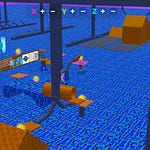Uses Sakura School to produce class that shows how autonomous robots can produce houses
Licenses: you can choose to use through Creative Commons Attribution 2.0, Apache 2, or GPLv2.
Sakura School prop import codes to use: #9417_0676_0249_26 (Island Backdrops 0.4.3.4.2)
#3517_0711_6043_24 (Autonomous Robos 0.2.2.2)
#4517_0711_6360_25 (Wood Shop Class 0.2.2.4.3)
Source code which groups Arduino (or Elegoo) tools to perform tasks, plus move around obstacles: https://github.com/SwuduSusuwu/SubStack/blob/preview/posts/ArduinoElegooTools.md. Lists of components with which to produce those: /ArduinoElegooTools.md#parts--kits-lists.
Specifics of the tools which those props represent: the scaffolds use simple linacs, the arms use 2-axis spherical joints socketed into “booms” (cylindrical tubes) with unshown mechanisms to move:
Recessed orthogonal rubber "rollers" (toothless friction-gears with smooth surfaces) in the tubes can (with torque transferred through friction onto the joints) do those 2-axis motions. Stepper motors (or servos) can cause 1 (or both) rollers to move. If the load requires huge torque, improve the friction-coefficient with: smooth surfaces, plus continuous variable transmission fluid (such as SantoTrac).
If round (2-axis) rollers are not used; while 1 roller moves, clutches must loosen the 2nd roller (so the 2nd roller does not "stick" (does not do as an automotive calliper on a drum does)).
Cords (such as those which move puppets) can also do so, but require linear actuators (to mimic myosin, which is fast but more complex) or reels (to extend / retract the cords, which is slow, since fast extension can cause the cords to sag, plus fast retraction causes cord-compression).
Dual orthogonal 1-axis hinges (such as Kuka's / Fanuc's tools use) are more simple (direct control of hinge through servo) plus can mimic 2-axis motions, but those look different than the props in this Sakura School show. Another problem with those is that the spatial offset (which separates the 2 hinges) prevents true 2-axis moves (although most dual-hinges are so close that this is not an issue for common use).
Amazon has 4kw servos for $52, which allow >2 billion humans to afford to produce autonomous tools. Use gear reduction (simple transmissions) to convert the high RPM into torque.
Sounds: Swudu Susuwu's organs 2024/02/04 (new: Swudu Susuwu's organs 2024/02/16)
Previous:
Tools used:
ffmpeg is FLOSS (no cost), plus is the best tool to: transcode, trim, demux or mux. ffmpeg is on Windows&Linux&Android OS&iOS&OSX.
[This post allows all uses.] For Table of Contents, view on GitHub.
+ https://play.google.com/store/apps/details?id=jp.garud.ssimulator
Synopsis + related posts
./posts/TranscodeMuxHowto.mdis simple/bin/shcommands for advancedffmpeguse.https://github.com/SwuduSusuwu/SusuMid.githas the sounds used.











